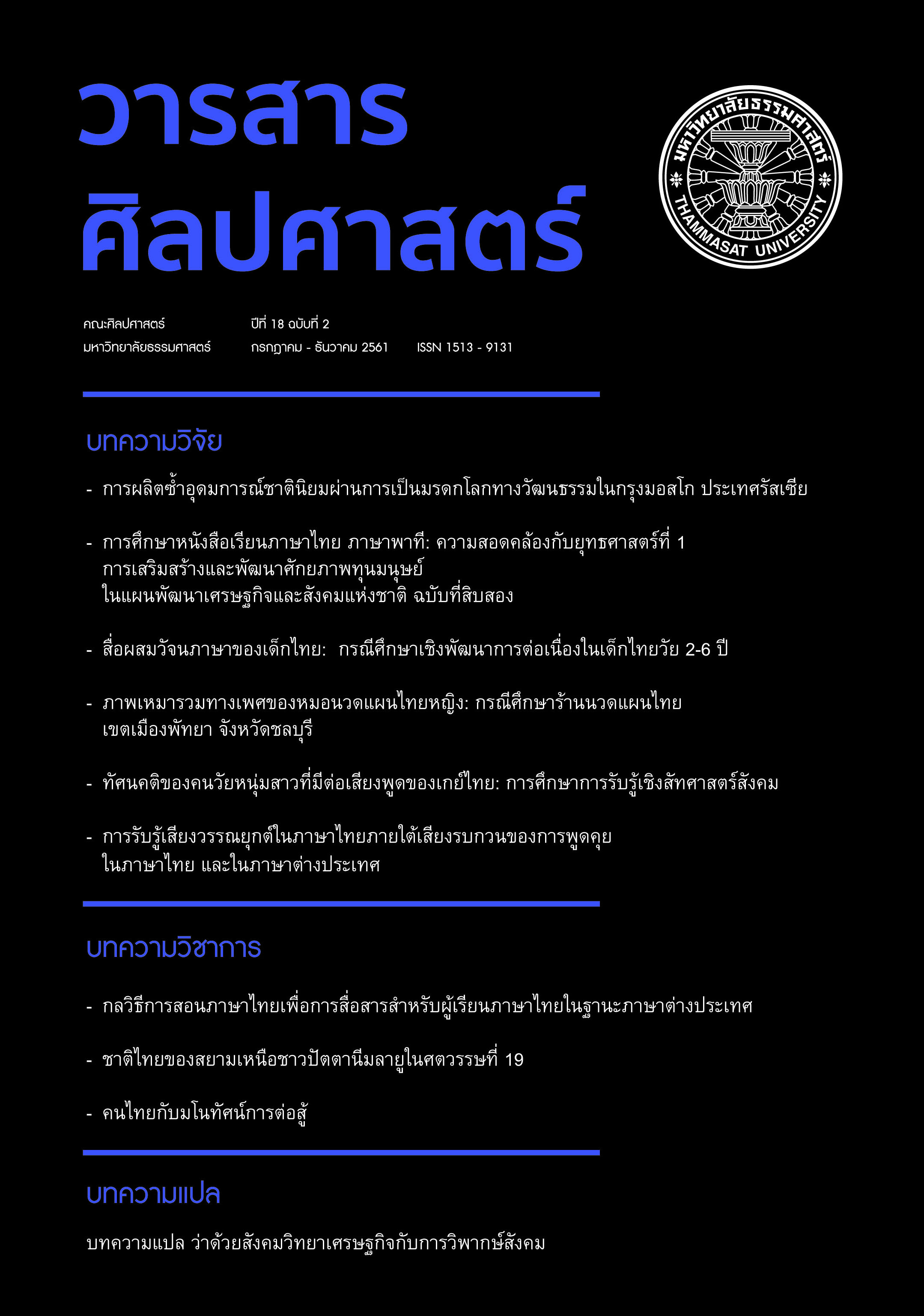ทัศนคติของคนวัยหนุ่มสาวที่มีต่อเสียงพูดของเกย์ไทย: การศึกษาการรับรู้เชิงสัทศาสตร์สังคม
Main Article Content
บทคัดย่อ
งานวิจัยนี้มีวัตถุประสงค์เพื่อศึกษาว่า คนไทยกลุ่มหนุ่มสาวสามารถแยกแยะเสียงเกย์ออกจากเสียงชายแท้ได้หรือไม่และคนไทยกลุ่มนี้มีทัศนคติอย่างไรต่อเสียงเกย์ผู้วิจัยได้ทำการทดลอง 2 ครั้ง ครั้งที่ 1 ผู้วิจัย ได้บันทึกเสียงพูดของเกย์และชายแท้ปะปนกันโดยแยกเป็นสถานการณ์ที่เป็นทางการและไม่เป็นทางการแล้วให้ กลุ่มผู้ฟังระบุว่า เสียงที่ได้ยินเป็นเสียงของชายหรือเกย์ผู้ฟังแบ่งออกเป็น 3 กลุ่มตามเพศสภาพ (gender) ได้แก่ กลุ่มชาย กลุ่มหญิง และกลุ่มเกย์ผลการทดลองครั้งที่ 1 ทำให้ทราบว่า กลุ่มผู้ฟังสามารถแยกแยะเสียงเกย์ออก จากเสียงชายแท้ได้อย่างชัดเจน และมีความมั่นใจในการระบุเสียง ส่วนในการทดลองครั้งที่ 2 ผู้วิจัยได้นำเสียงที่ เป็นตัวแทนของชายแท้และเกย์มาให้ผู้ฟังประเมินทัศนคติด้านบุคลิกลักษณะ 8 ด้าน ผลการทดลองครั้งที่ 2 พบว่า กลุ่มผู้ฟังมิได้มีทัศนคติไปในทางลบต่อเสียงเกย์หรือชายแท้แต่มีความชื่นชอบเสียงชายแท้มากกว่าเสียงเกย์ สอดคล้องกับการรับรู้โดยทั่วไปของสังคมไทย ที่มีแนวโน้มยอมรับการมีอยู่ของเพศที่สามมากขึ้นกว่าเดิม
Downloads
Article Details

This work is licensed under a Creative Commons Attribution-NonCommercial-NoDerivatives 4.0 International License.
References
กมลวรรณ ชมวงษ์. (2546). ทัศนคติทางภาษาของนักศึกษาไทย (หลักสูตรนานาชาติและหลักสูตรปกติ) ที่มีต่อการพูดภาษาอังกฤษในหมู่คนไทย (วิทยานิพนธ์ปริญญามหาบัณฑิต). มหาวิทยาลัยธรรมศาสตร์.
กรุงเทพธุรกิจออนไลน์. รธน.ใหม่รับรองเพศสภาพเท่าเทียม.สืบค้นเมื่อ 11 พฤษภาคม 2560 จาก http://www.bangkokbiznews.com/news/detail/628781
กฤตยา อาชวนิจกุล. (2554). เพศวิถีที่กำลังเปลี่ยนแปลงไปในสังคมไทย. วารสารประชากรและสังคม, 15(1), 43-65.
จรัญวิไล จรูญโรจน์, ม.ล. (2556). ทัศนคติของนิสิตระดับอุดมศึกษาต่อการใช้ภาษาของอาจารย์. วารสารมนุษยศาสตร์, 20, 167-188.
จรัญวิไล จรูญโรจน์, ม.ล.และYang Lizhou. (2559). ทัศนคติต่อคนไทยและคนจีนของชาวจีนที่เรียนภาษาไทยและชาวไทยที่เรียนภาษาจีน: การศึกษาด้วยกลวิธีพรางเสียงคู่. วารสารมนุษยศาสตร์ ฉบับบัณฑิตศึกษามหาวิทยาลัยรามคำแหง, 4(2), 16-35.
ชลิดาภรณ์ ส่งสัมพันธ์. (2551). เพศวิถี: นิยามความหมายและพัฒนาการกรอบแนวคิด. สืบค้นเมื่อ 1 เมษายน2560 จาก http://www.teenpath.net/data/event/40003/Teen01/content-001.html
นิด้าโพล. สังคมไทยคิดอย่างไรกับเพศที่สาม. สืบค้นเมื่อ 11 พฤษภาคม 2560 จาก http://nidapoll.nida.ac.th/ index.php?op=polls-detail&id=317
มุกสไปดี. (7 มีนาคม 2557). กระเทยทำไมต้องทำเสียงแปลกๆ ที่ผู้หญิงไม่ใช่ ผู้ชายยิ่งไม่ใช่ใหญ่ [เว็บบอร์ด]. จาก http://pantip.com/topic/31747668
ยุทธนา นันทวัธวิภา. (2547). ภาษาเกย์: การศึกษาวิเคราะห์ (ปริญญานิพนธ์ปริญญามหาบัณฑิต). มหาวิทยาลัยศรีนครินทรวิโรฒ.
ศศิธร ธาตุเหล็ก. (2541). ทัศนคติของคนในกรุงเทพมหานครที่มีต่อการพูดภาษาไทยปนภาษาอังกฤษ (วิทยานิพนธ์ปริญญามหาบัณฑิต). มหาวิทยาลัยธรรมศาสตร์.
ศิริรัตน์ ชูพันธ์ อรรถพลพิพัฒน์. (2556). ทัศนคติของคนกะเหรี่ยงที่มีต่อภาษากะเหรี่ยงและภาษาไทย. วารสารมนุษยศาสตร์และสังคมศาสตร์ มหาวิทยาลัยราชภัฏสุราษฏร์ธานี, 5(1), 113-135.
สุพัตรา สมนึก. (2550). กลวิธีการเรียนและทัศนคติที่มีต่อภาษาไทยของนักเรียนไทยมุสลิมระดับมัธยมศึกษาตอนต้น อำเภอเมือง จังหวัดยะลา (วิทยานิพนธ์ปริญญามหาบัณฑิต). มหาวิทยาลัยธรรมศาสตร์.
อารีวรรณ เลิศธนะ. (2548). การแปรของเสียงวรรณยุกต์โทตามเพศของผู้พูดในภาษาไทยกรุงเทพฯ และทัศนคติของผู้ฟัง (วิทยานิพนธ์ปริญญามหาบัณฑิต). มหาวิทยาลัยธรรมศาสตร์.
Baker, C. (1992). Attitudes and Language. Avon: Multilingual Matters.
Callier, P. (2011). Social meaning in prosodic variability. University of Pennsylvania Working Papers in Linguistics, 17(1), 39-50. Retrieved from http://repository.upenn.edu/pwpl/vol17/iss1/6/
Carahaly, L. N. (2000). Listener accuracy in identifying the sexual orientation of male and female speakers (Master’s thesis). The Ohio State University.
Gardner, R. C., & Lambert, W. E. (1972). Attitudes and motivation in second-language learning. Essex, MA: Newbury House.
Gaudio, R. P. (1994). Sounding gay: Pitch properties in the speech of gay and straight men. American Speech, 69(1), 30-57.
Hau, Chi-Kuk. (2007). A study on acoustic characteristics of Cantonese gay speech and perceived sexual orientation (Master’s thesis). The Chinese University of Hong Kong.
Henton, C. (1989). Fact and fiction in the description of female and male pitch. Language & Communication, 9(4), 299-311.
Henton, C., & Blandon, A. (1988). Creak as a socio phonetic marker. In L. Hyman, & N. L. Charles (Eds.), Language, Speech, and Mind (pp. 3-29). London: Routledge.
Kajino, S. (2010). Coexistence of contradictory meanings of a variable: Phrasal final lengthening in speech of a Japanese pop star Ayumi Hamasaki. Paper presented at the New Ways of Analyzing Variation (NWAV) 39 Conference, University of Texas at San Antonio.
Lakoff, R. (1975). Language and Woman’s Place. New York, NY: Harper & Row.
Lambert, W. E., Hodgsen, R. C., Gardner, R. D., & Fillenbaum, S. (1960). Evaluational reaction to spoken language. Journal of Abnormal and Social Psychology, 60, 44-51.
Levon, E. (2006). Hearing ‘gay’: Prosody, interpretation, and the affective judgments of men’s speech. American Speech, 8, 56-78.
Levon, E. (2007). Sexuality in context: Variation and the sociolinguistic perception of identity. Language in Society, 36(4), 533-554.
Linville, S. E. (1998). Acoustic correlates of perceived versus actual sexual orientation in men’s speech. Folia Phoniatrica et Logopaedica, 50(1), 35-48.
Lowry, O. (2002). The stylistic variation of nuclear pattern in Belfast English. Journal of the International Phonetic Association, 32(1), 33-42.
Mendoza-Denton, N. (1995). Pragnant pauses: Silence and authority in the Anita Hill-Clarence Thomas hearings. In K. Hall, & M. Bucholtz (Eds.), Gender Articulated: Language and the Culturally Constructed Self (pp. 51-66). New York, NY: Routledge.
Munson, B. (2007). The acoustic correlates of perceived masculinity, perceived femininity, and perceived sexual orientation. Language and Speech, 50(1), 125-142.
Munson, B., Sarah, V. J., & Elizabeth C. M. (2006). The influence of perceived sexual orientation on fricative perception. Journal of the Acoustical Society of America, 119(4), 2427-2437.
Ohala, J. J. (1984). An ethnological perspective on common cross-language utilization of voice. Phonetica, 41, 1-16.
Palikupt, D. (1983). Central Thai and northeastern Thai: A linguistic and attitudinal study. (Doctoral Dissertation). University of Texas at Austin.
Piccolo, F. (2008). Perceived sexual orientation and attitudes towards sounding gay or straight. University of Pensylvania Working Papers in Linguistics, 14(2), 130-138.
Pierrehumbert, J. B., Bent, T., Munson, B., Bradlow, A. R., & Bailey, M. J. (2004). The influence of sexual orientation on vowel production. Journal of the Acoustical Society of America, 116(4), 1905-1908.
Podesva, R. J., & Kajino, S. (2014). Sociophonetics, gender, and sexuality. In S. Ehrlich, M. Meyerhoff, & J. Holmes (Eds.), The Handbook of Language, Gender, and Sexuality (2nd ed.) (pp. 103-122). West Sussex: Wiley Blackwell.
Podesva, R. J., Roberts, S. J., & Campbell-Kibler, K. (2001). Sharing resources in the production of gay styles. Language and Sexuality Contesting Meaning in Theory and Practice (pp.175-189). Santa Clara, CA: Stanford.
Saisuwan, P. (2011). Kathoey’s and women’s use of first-person reference terms in Thai (Master’s thesis). The University of Edinburgh.
Saisuwan, P. (2016). Male femininity in Thai among men who identify with non-normative male roles (Doctoral dissertation). Queen Mary University of London.
Smyth, R., Jacobs, G., & Rogers, H. (2003). Male voices and perceived sexual orientation: An experimental and theoretical approach. Language in Society, 32(3), 329-350.
Thomas, E. R. (2011). Sociophonetics: An introduction. London: Palgrave Macmillan.
Valentova, J. V., & Havlicek, J. (2013). Perceived sexual orientation based on vocal and facial stimuli is linked to self-rated sexual orientation in Czech Men. San Francisco, CA: PLOS One.
Zimman, L. (2013). Hegemonic masculinity and the variability of gay-sounding speech: The perceived sexuality of transgender men. Journal of Language and Sexuality, 2(1), 1-39.

